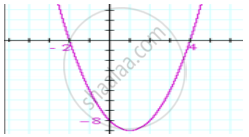Advertisements
Advertisements
Question
Divide. Write the quotient and the remainder.
(2y3 + 4y2 + 3) ÷ 2y2
Solution
(2y3 + 4y2 + 3) ÷ 2y2
= \[\frac{2 y^3 + 4 y^2 + 3}{2 y^2}\]
= \[\frac{2 y^2 \left( y + 2 \right) + 3}{2 y^2}\]
= \[\frac{2 y^2 \left( y + 2 \right)}{2 y^2} + \frac{3}{2 y^2}\]
= \[\left( y + 2 \right) + \frac{3}{2 y^2}\]
So, quotient = \[\left(y + 2 \right)\] and remainder = 3
RELATED QUESTIONS
Classify the following polynomials as linear, quadratic, cubic and biquadratic polynomials:
`2x+x^2`
Classify the following polynomials as polynomials in one-variable, two variables etc:
`x^2-2tx+7t^2-x+t`
If α, β are the zeros of a polynomial such that α + β = −6 and αβ = −4, then write the polynomial.
If the diagram in Fig. 2.22 shows the graph of the polynomial f(x) = ax2 + bx + c, then

If the product of two zeros of the polynomial f(x) = 2x3 + 6x2 − 4x + 9 is 3, then its third zero is
State whether the given algebraic expression are polynomial? Justify.
`y + 1/y`
Given that two of the zeroes of the cubic poly-nomial ax3 + bx2 + cx + d are 0, the third zero is ______.
An asana is a body posture, originally and still a general term for a sitting meditation pose, and later extended in hatha yoga and modern yoga as exercise, to any type of pose or position, adding reclining, standing, inverted, twisting, and balancing poses. In the figure, one can observe that poses can be related to representation of quadratic polynomial.


The two zeroes in the below shown graph are:

Determine the degree of the following polynomial:
x3 – 9x + 3x5
Classify the following as a constant, linear, quadratic and cubic polynomials:
2 + x
